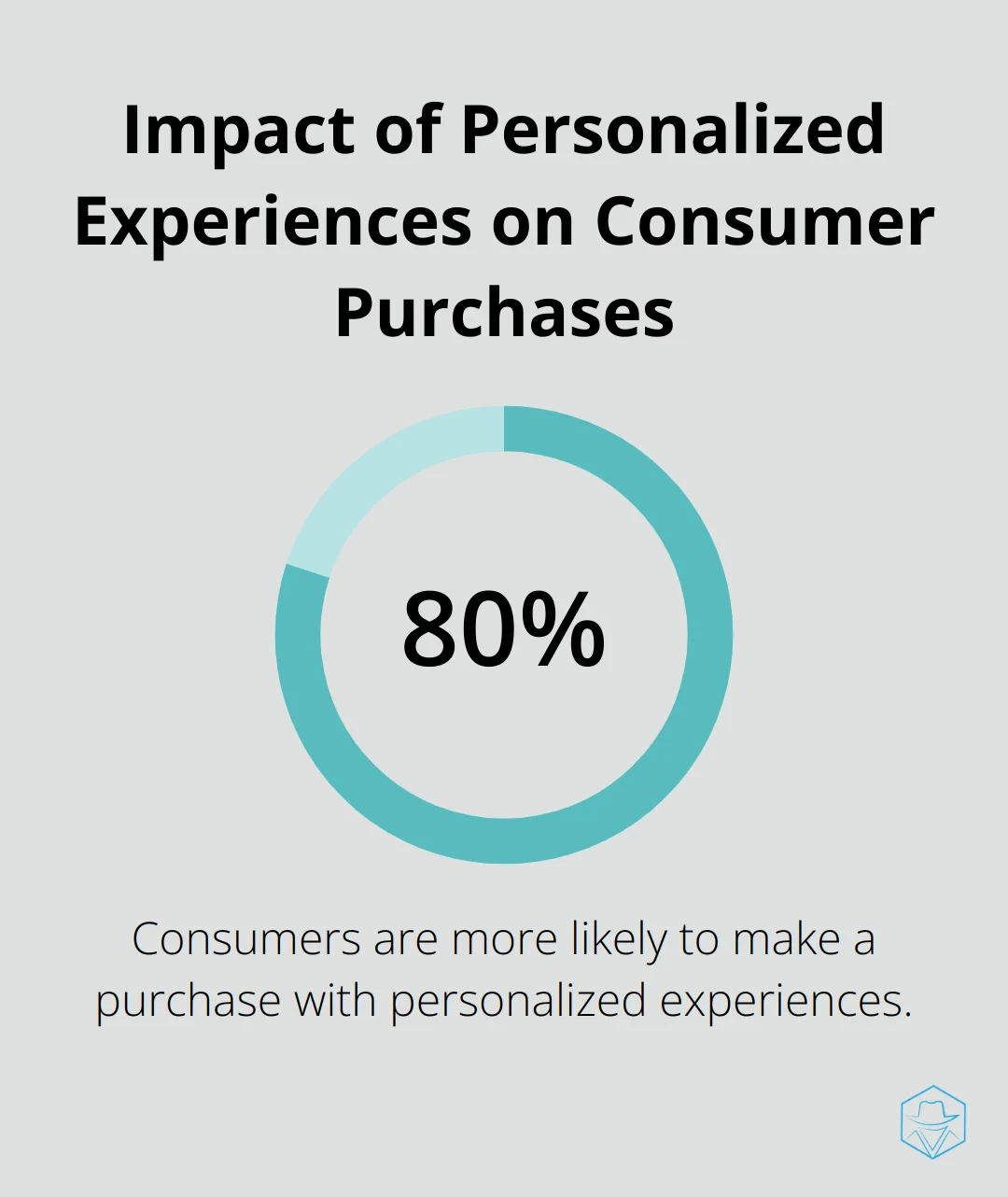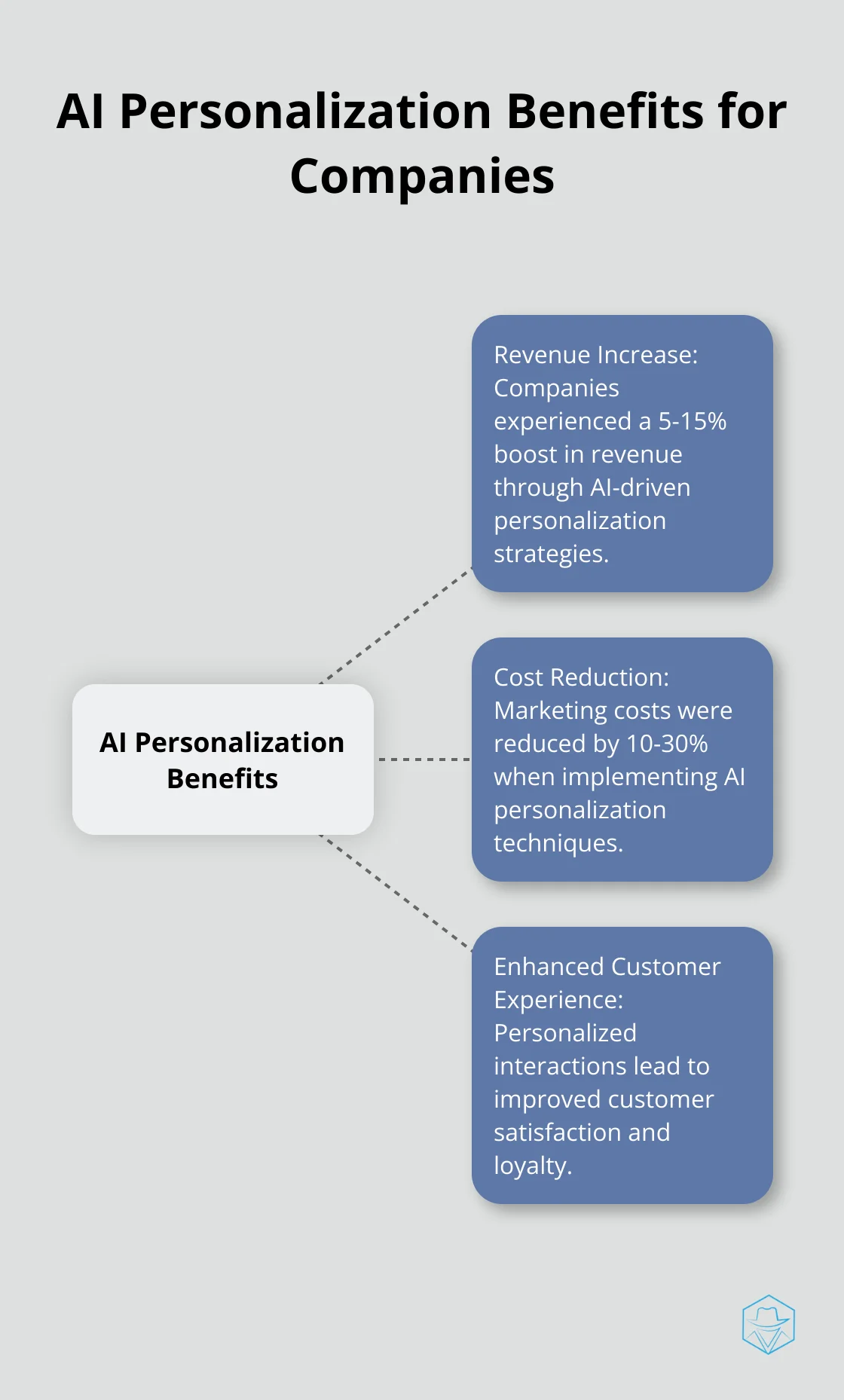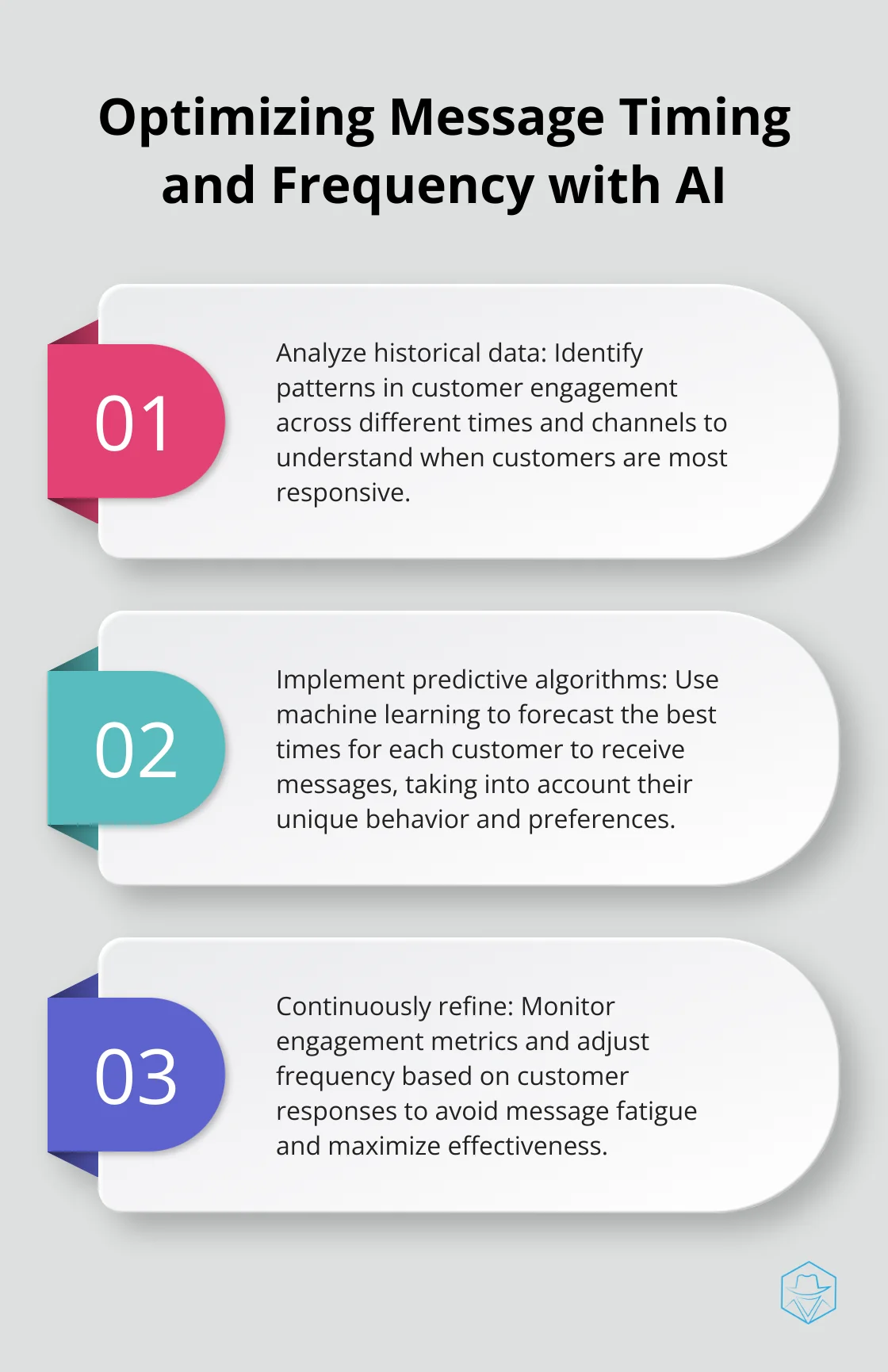Leveraging AI for Deep Message Personalization

At Drop Cowboy, we’re excited about the transformative power of AI personalization in messaging. This technology is reshaping how businesses communicate with their customers, creating more meaningful and engaging interactions.
AI’s ability to analyze vast amounts of data and understand customer behavior is revolutionizing message personalization. In this post, we’ll explore how AI is being leveraged to create deeply personalized messages that resonate with audiences on an individual level.
How AI Revolutionizes Message Personalization
Decoding Customer Behavior with AI
AI algorithms analyze customer interactions across multiple touchpoints. They track website visits, purchase history, email opens, and social media engagement. This comprehensive view allows businesses to understand customer preferences at a granular level.
For example, AI can identify that a customer frequently browses running shoes but hasn’t made a purchase. It can then trigger a personalized message with a special offer on running shoes, increasing the likelihood of conversion.
Real-Time Data Analysis for Instant Personalization
The power of AI lies in its ability to process vast amounts of data in real-time. This means personalization isn’t limited to pre-planned campaigns. It happens instantly, as customers interact with your brand.
A study by Epsilon found that 80% of consumers are more likely to make a purchase when brands offer personalized experiences. AI makes this level of personalization possible at scale.

Crafting Hyper-Relevant Content
AI doesn’t just analyze data; it uses that data to create highly targeted content. Natural Language Processing (NLP) algorithms can generate personalized product descriptions, email subject lines, and even entire marketing emails.
Mimic AI™ technology takes this a step further. It allows businesses to clone their voice for personalized voicemail messages, creating a unique and engaging experience for each customer.
Predictive Personalization
The most exciting aspect of AI in message personalization is its predictive capabilities. AI can anticipate customer needs and preferences before they even express them.
For instance, if a customer typically makes a purchase every three months, AI can trigger a personalized offer just before that three-month mark. This proactive approach to personalization can significantly boost customer loyalty and lifetime value.
The Future of AI-Driven Personalization
As AI technology continues to advance, we can expect even more innovative applications in personalized messaging. From voice-activated assistants that understand context and emotion to augmented reality experiences tailored to individual preferences, the possibilities are endless.
Companies that embrace these AI-driven personalization techniques (and implement them ethically) will likely see increased customer engagement, higher conversion rates, and improved brand loyalty. The next chapter will explore the key AI technologies that make this level of personalization possible.
AI Technologies Powering Message Personalization
At Drop Cowboy, we’ve witnessed the transformative impact of AI technologies on message personalization. This chapter explores the key AI technologies that enable more effective communication and how businesses can harness their power.
Natural Language Processing: Decoding Customer Intent
Natural Language Processing (NLP) revolutionizes content analysis. It empowers AI systems to interpret human language, including context and sentiment. This technology creates personalized messages that strike a chord with individual customers.
NLP analyzes customer reviews and social media posts to uncover common pain points or desires. Businesses then craft highly targeted marketing messages based on these insights. A study by Accenture revealed that 91% of consumers prefer to shop with brands that provide relevant offers and recommendations.
Machine Learning: Forecasting Customer Behavior
Machine Learning algorithms fuel predictive modeling in message personalization. These algorithms scrutinize vast amounts of historical data to identify patterns and forecast future behavior.
Machine learning predicts products a customer might like based on their browsing history, purchase patterns, and demographic information. This enables businesses to send personalized product recommendations with a higher conversion potential.
A McKinsey & Company report highlighted that companies using AI for personalization experienced a 5-15% increase in revenue and a 10-30% reduction in marketing costs.

Computer Vision: Customizing Visual Content
Computer Vision technology elevates personalization by analyzing and customizing visual content. This AI technology recognizes objects, faces, and scenes in images and videos, allowing for highly personalized visual messaging.
An e-commerce platform could use computer vision to analyze a customer’s Instagram photos and recommend products that match their style. Similarly, a travel company could personalize their marketing emails with images of destinations that align with a customer’s past travel preferences.
Voice Cloning: Personalizing Audio Messages
Voice cloning technology (like Drop Cowboy’s Mimic AI™) allows businesses to create personalized voicemail messages that sound like a real person. This technology enhances engagement by providing a unique and personal touch to audio communications.
Smart Delivery: Optimizing Message Delivery
AI-powered smart delivery systems (such as Drop Cowboy’s Smart Delivery™) optimize the timing and method of message delivery. These systems analyze factors like time zones, past engagement patterns, and preferred communication channels to ensure messages reach customers at the most opportune moments.
The integration of these AI technologies creates a powerful toolkit for businesses to craft deeply personalized messages. In the next chapter, we’ll explore strategies for implementing these AI-driven personalization techniques effectively.
How to Implement AI-Driven Personalization
Hyper-Segmentation: Beyond Traditional Demographics
AI enables hyper-segmentation, which moves beyond basic demographics to create micro-segments based on behavior, preferences, and predictive analysis. A Salesforce study found that 52% of consumers expect personalized offers, highlighting the importance of this level of segmentation.
To implement hyper-segmentation:
- Collect comprehensive data across all customer touchpoints
- Use AI algorithms to identify patterns and create micro-segments
- Develop tailored messaging for each segment
- Refine segments continuously based on new data and interactions
An e-commerce company might segment customers not just by age and location, but by browsing behavior, purchase frequency, and predicted lifetime value. This approach allows for highly targeted campaigns that speak directly to each customer’s needs and preferences.
Dynamic Content: Adapting in Real-Time
Dynamic content adapts based on user interactions, creating a personalized experience for each individual. Epsilon reports that 80% of consumers are more likely to make a purchase when brands offer personalized experiences.
To implement dynamic content:
- Create a content library with various options for each element (e.g., headlines, images, CTAs)
- Use AI to analyze user data and select the most appropriate content for each individual
- Implement A/B testing to optimize content selection continuously
- Use tools that create personalized voice messages adapting to each recipient
An email campaign where the subject line, product recommendations, and even the sender name change based on the recipient’s past interactions and preferences serves as a practical example of dynamic content.
AI-Optimized Timing and Frequency
Timing plays a critical role in marketing, and AI can determine the optimal time to send messages to each individual customer. An Omnisend study found that sending three abandoned cart emails results in 69% more orders than a single email.

To optimize timing and frequency:
- Analyze historical data to identify patterns in customer engagement
- Use machine learning algorithms to predict the best times for each customer to receive messages
- Implement send-time optimization in your marketing automation platform
- Monitor and adjust frequency based on engagement metrics to avoid fatigue
An AI system might learn that a particular customer engages with emails most often on Tuesday mornings and adjust the send time accordingly.
Personalized Product Recommendations
AI-powered recommendation engines analyze customer behavior and preferences to suggest products tailored to individual tastes. This personalization can significantly boost conversion rates and average order value.
To implement personalized product recommendations:
- Collect and analyze customer browsing and purchase history
- Use collaborative filtering algorithms to identify similar customers and their preferences
- Implement content-based filtering to recommend products based on item attributes
- Combine these approaches for hybrid recommendation systems
For example, an online bookstore might recommend science fiction novels to a customer who frequently purchases books in that genre, while also suggesting related genres based on similar customers’ preferences.
AI-Driven Chatbots and Virtual Assistants
AI-powered chatbots and virtual assistants provide personalized customer service at scale. These tools can handle inquiries, offer product recommendations, and guide customers through the purchase process, all while adapting their responses based on individual customer data.
To implement AI-driven chatbots:
- Define the primary use cases and goals for your chatbot
- Train the AI on your product catalog and frequently asked questions
- Integrate the chatbot with your customer database for personalized interactions
- Continuously improve the chatbot’s responses based on user feedback and interactions
A clothing retailer might use an AI chatbot to help customers find the perfect outfit by asking about their style preferences, body type, and occasion, then providing tailored recommendations.
Final Thoughts
AI personalization transforms how businesses communicate with customers. It analyzes data in real-time, understands behavior, and predicts preferences to create hyper-relevant content. This technology optimizes message timing and frequency, delivering personalized experiences across multiple channels. AI personalization extends beyond marketing to revolutionize customer service, product development, and internal communications.
The future of communication will become more personal as AI continues to evolve. We expect advancements in voice recognition and emotion detection, allowing for nuanced personalization. Augmented reality experiences tailored to individual preferences may become commonplace, further enhancing customer interactions. However, businesses must prioritize data privacy and transparency to build trust with customers as they adopt these technologies.
Drop Cowboy’s innovative platform offers AI-powered tools to help businesses create personalized messages that connect with their audience. The future of communication is personal, and AI unlocks its full potential. Businesses should adopt AI personalization strategies now to create meaningful connections, drive engagement, and achieve better results.
blog-dropcowboy-com
Related posts

April 14, 2025
Best Shopify Email Marketing Strategies for Conversions
Boost sales with the best Shopify email marketing strategies. Learn proven tips to increase conversions and enhance customer engagement.

July 20, 2025
Is EZ Texting Worth It? User Reviews and Insights
Explore EZ Texting reviews to assess its value. Dive into user insights for informed decisions on business communication solutions.

August 4, 2025
Why does my phone go directly to voicemail
Explore why your phone goes directly to voicemail. Uncover causes like Do Not Disturb, network issues, and battery problems for quick solutions.

July 20, 2025
Predictive Dialer vs Power Dialer: Which to Choose?
Compare predictive dialer vs power dialer, learn their differences, and decide on the best tool to optimize your call strategy for efficiency and success.

August 4, 2025
Phone straight to voicemail
Explore why calls go phone straight to voicemail and discover strategies to optimize communication efficiency easily.

April 4, 2025
Marketing Automation Example: Boosting Conversions
Boost conversions with a marketing automation example that highlights practical tips, tools, and real-world data for enhanced lead generation.